BRICS and South-South and triangular cooperation
BRICS countries, stronger together
More information about the ITCILO's approach to BRICS and South-South and triangular cooperation
BRICS
BRICS countries are key stakeholders for the ILO and ITCILO. BRICS countries' GDP accounts for 28% of global economic output. The countries are a major destination and source of FDI and their MNE exert strong leverage over labour practices in selected global production systems (2008 Declaration on Social Justice for a fair Globalization).
BRICS countries are perceived to be a distinct customer segment. The group has a strong self-perception of not belonging to the traditional Western block of developed countries, while the broader group of middle-income and developing countries likewise perceive them not to be one of their own.
BRICS countries require tailored capacity-building support services that respond to local contexts and complement local expertise, a view echoed in the recent ILO field operations review that calls for a reclassification of member countries in line with their specific needs. These countries do not fit the mainstream development paradigm and the capacity of local ILO constituents and other stakeholders is often highly advanced.
BRICS countries constitute training service markets that require more market-oriented funding mechanisms. Local ILO constituents and stakeholders are highly price-sensitive due to strong competition among local and international service providers. Funding from traditional multi-bilateral partners is diminishing and thus challenging the traditional ITCILO business model. Alternative finances are self-paying customers, co-funding from non-traditional development partners, or a combination of these two sources of financing.
The link with the broader ILO partnership development approach
The ITCILO outreach strategy in BRICS is guided by the higher-level partnership development approach adopted by the ILO. Mindful of the need to explore market-oriented funding mechanisms for ITCILO capacity building support in BRICS countries, the recent ILO guidelines on the engagement with non-traditional development partners and on the facilitation of non-traditional collaboration mechanisms are particularly relevant; Governing Body papers released in March 2014 refer to:
- The strategy paper for wider ILO engagement with the private sector (GB.320/INS/51)
- The analysis of public private partnerships between the ILO and private sector partners (GB.320/INS/5/2)
- The paper on South-South and triangular cooperation (GB.313/POL/7)
At the 332nd Session of the ILO Governing Body in March 2018, an update and report in the document “ILO South–South and triangular cooperation and decent work: Recent developments and future steps” was presented. The document reports on the implementation of the ILO South-South and triangular cooperation (SSTC) strategy adopted by the Governing Body in March 2012 and proposes future SSTC steps with a view to informing the forthcoming general discussion on effective development cooperation in support of the United Nations Sustainable Development Goals at the 107th Session of the International Labour Conference. The decision requests the Office to take into account the initial guidance provided in the current Governing Body discussion on SSTC, as well as the recommendations for future steps, in the forthcoming general discussion on effective development cooperation in support of the SDGs at the 107th Session of the International Labour Conference (see draft decision in paragraph 23).
South-South and triangular cooperation
South-South and triangular cooperation is a funding mechanism and development tool increasingly used to achieve the ILO Decent Work Agenda, which has become a global goal and a universal commitment.
The time has come to understand development cooperation as more than a mere portfolio of projects funded by voluntary contributions and transfers to developing countries. It is now part of a broader international effort aligned with the 2030 Agenda, in which the ITCILO help to promote the ILO Decent Work Agenda through institutional capacity development.
South-South development cooperation has been extensively promoted and applied by the fast growing economies of Brazil, Russia, India, China, and South Africa (BRICS) which are forming a leading position and thus representing a pivotal new model of cooperation between countries from the Global South.
For more information about South-South and triangular cooperation, see the following links:
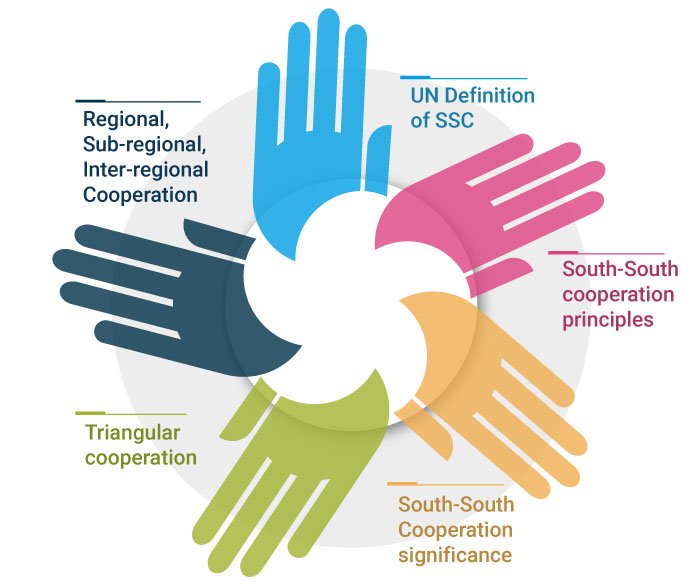
- UN Definition of SSC
- South-South cooperation principles
- South-South Cooperation significance
- Triangular cooperation
- Regional, Sub-regional, Inter-regional Cooperation
The United Nations defines South-South Cooperation (SSC) as “a process whereby two or more developing countries pursue their individual and/or shared national capacity development objectives through exchanges of knowledge, skills, resources and technical know-how, and through regional and interregional collective actions, including partnerships involving governments, regional organizations, civil society, academia and the private sector, for their individual and/or mutual benefit within and across regions. South-South cooperation is not a substitute for, but rather a complement to, North-South cooperation”. The SSC agenda is guiding by the principles of respect for national sovereignty, national ownership and independence, equality, non-conditionality, non-interference in domestic affairs, and mutual benefit.
http://www.undp.org/content/undp/en/home/development-impact/south-south-cooperation.html
South-South Cooperation in practical terms means A partnership between equals; mutual sharing and exchange of key development solutions between countries from the Global South. It encompasses a multi-stakeholder approach. Represents a complement and not a substitute of traditional North-South cooperation.
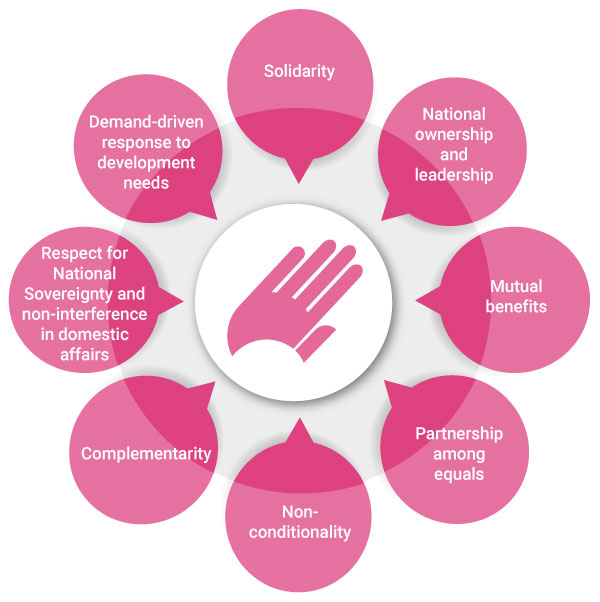
- Positive effects of cultural, economic, political or social exchange and proximity among countries that practice it.
- Similar development levels and experiences make good practices from one country highly adaptable to another country from the South.
- Sharing and adapting evidence-based good practices is a cost- effective mean to address development challenges.
- Cooperation between two or more countries from the South with a country from the North.
- Assistance from the North could be in the form of financial contribution or technical expertise.
- It must be driven by the developing countries involved and in line with their national priorities.
- Horizontality.
This is the most common type of cooperation between countries from the South and happens in the framework of regional, sub-regional, inter-regional groups/platforms.
Some examples are the following:
Regional – African Union, ASEAN
Sub-regional – MERCOSUR
Inter-regional - CPLP, BRICS, IBSA
Regional
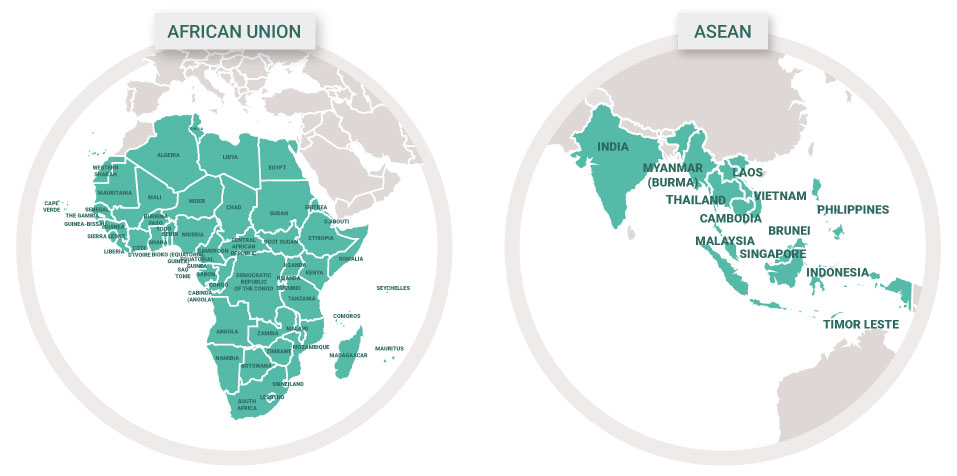
Subregional
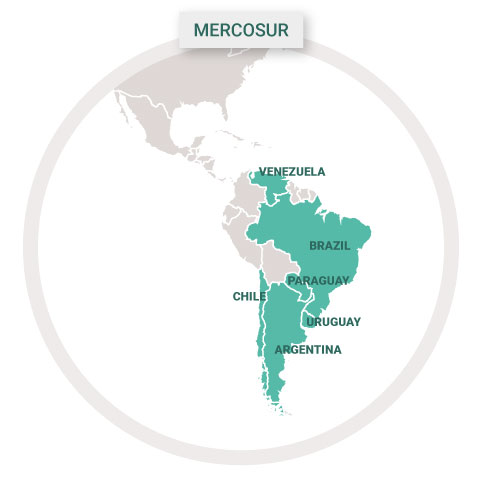
Inter-regional
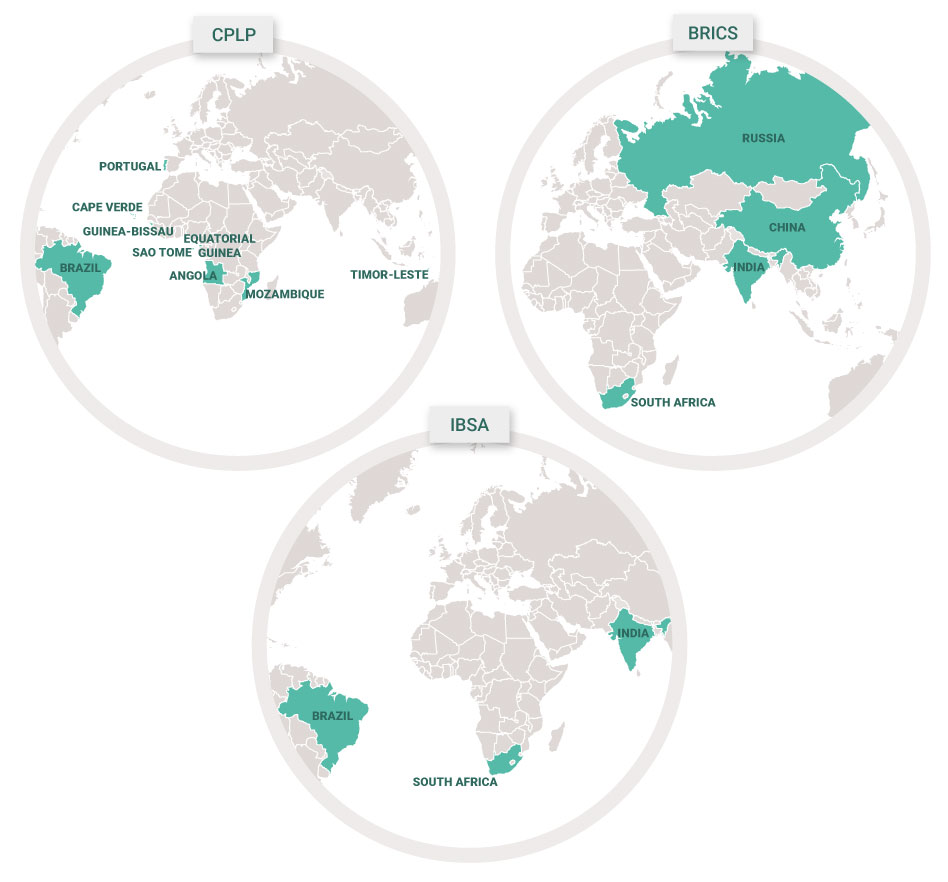
Events
2018
- BRICS Expert Forum on Youth Employment (ITCILO, 28-30 November 2018)
- Global South-South Development Expo 2018 (New York, 28-30 November 2018)
- Project on "The Future of Work in Asia: Skills development strategies and social protection policies to promote employment-rich and equitable growth", financed by the Chinese Ministry of Human Resources and Social Security
- Expert meeting on the Future of Work in Asia: Skills development strategies to promote employment-rich and equitable growth in the care economy (Turin, Italy, 17-19 September 2018)
- Regional Training Workshop on Quality Apprenticeships (Siem Reap, Cambodia, 10-14 December 2018)
- Challenges and opportunities for the extension of social protection arising from the new forms of employment in ASEAN and China Expert meeting (Bangkok, Thailand, 13-14 December 2018)
- Workshop on Care Sector Approaches to Skills Development (Dhaka, Bangladesh, 21-22 January 2019)
- South-South and triangular cooperation and the Care Economy: Research papers and articles compendium
2017
- Global South-South Development Expo 2017: ILO Solution on Skills Development, Youth Employment in the framework of South-South and triangular Cooperation (Antalya, Turkey, 27-30 November 2017)
- Work and Society Workshop (Turin, Italy, 21-22 September 2017)
- Roundtable on the link between Demographic Change, Decent Work and Silver Entrepreneurship Development in Asia and Europe (Turin, Italy, 18-19 May 2017)
2016
- ILO-China-ASEAN High Level Seminar to achieve the SDGs on Universal Social Protection through South-South and Triangular Cooperation (Beijing, China, 6-8 September 2017)
- South-South and Triangular Cooperation Academy (Turin, Italy, 11-15 July 2016)
Resources
- South-South and triangular cooperation and the Care Economy: Research papers and articles compendium
- Social and solidarity economy in Asia: A South-South and triangular cooperation perspective
- Localizing the Decent Work Agenda through South-South and city-to-city cooperation
- South-South and triangular cooperation and decent work: Focus on triangular cooperation
- Triangular cooperation and decent work: Good practices
- Mapping the SSE landscape in India and Brazil through South-South and triangular cooperation: Gender-based initiatives in social and solidarity economy
- South-South And Triangular Cooperation Academy: A decent work overview
- The future of work and South-South and triangular cooperation
- Academy on social and solidarity economy: Innovative ecosystems for solidarity economy policies and South-South cooperation
- Sul-Sul Solidario e Desenvolvimento Local: Artigos dos Participantes - Praia, 20-22 Julho 2017
- Promover el empleo de las personas con discapacidad a través de redes empresariales en materia de discapacidad: Una perspectiva de cooperación Sur-Sur
